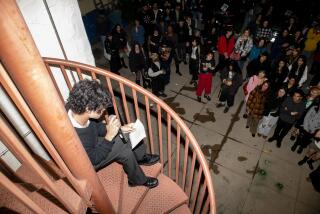Can’t Follow Wired’s ‘Style’? Hey, That’s JTB (Just Too Bad)
- Share via
Back when the potential of the personal computer was still the subject of speculation--we’re talking the distant 1970s here--its inventors cherished the ideal of making personal computing devices simple enough for even a child to use.
Over the intervening decades that hope has receded, even as the PC’s power has increased beyond its developers’ wildest imaginations. Ease of use may still be the ideal of a handful of visionaries (Alan Kay of Apple comes to mind) but the digital world today often seems to be occupied by an arrogant cadre intent on making technology more confounding, more elitist, more a fashion accessory for haute culture than an empowering tool for the masses.
Nowhere is this sensibility more vividly on display than in the pages of Wired magazine. As glossy and replete with fashion ads as an issue of Vanity Fair, Wired devotes itself not only to chronicling the comings and goings of the digital elite, but in creating its own vernacular to do so.
In open homage to Tom Wolfe and the “New Journalism” of the ‘70s, Wired claims to be pioneering a new style of magazine writing--”Way New Journalism”--that’s uniquely suited to the liberated, spontaneous, mercurial vernacular of e-mail and the Net.
But this quest for a new means of expression raises many more questions than it settles. In a world of unparalleled access to undigested information, Wired exalts writing that offers everything but the one quality more needed today than ever: clarity.
And now that the magazine has established itself as at least a commercial, and possibly a cultural, force, it has released what might be considered its manifesto, a 158-page handbook printed on neon yellow stock and modestly titled “Wired Style: Principles of English Usage in the Digital Age.”
Purporting to be a style manual and glossary of high-tech terminology, “Wired Style” is much more: It’s a window into the very sensibility of the magazine.
As stylebooks go, “Wired Style” is a curious specimen. The classic writing manuals, from Strunk and White’s “Elements of Style” to the Associated Press stylebook, seek to establish rules aimed at including the reader in the game by providing signposts of diction, grammar and vocabulary. They don’t demand lock-step allegiance to every rule, but they do foster clarity.
That’s too tired for “Wired Style”; too “data-drowned,” “oh-so-conventional,” “pureed” and lacking “verve.” Instead, it urges its writers to go “for the gonzo, the rough-edged, the over-the-top.”
“Voice,” proclaims “Wired Style,” “is paramount.”
In a way, it’s unsurprising that “Wired Style” would strive to elevate the medium over the message. It’s hard to think of a more incongruous environment for real ideas and communication than Wired magazine’s gimcrack graphics and organizational perversity. (Actually locating an article within any given issue of Wired is the only reading experience I can name that actually takes longer than downloading a Web page from the Internet.)
What is surprising about the stylebook, however, is its inconsistency even on its own terms.
Communicating online, says “Wired Style,” puts “a high premium on brevity, direct declarative sentences and a high signal-to-noise ratio.” Wired extols the style of e-mail as the voice of the “quirky, individualist spirit of the Net. . . . The voice of people who write the way they talk.”
Sure, the real voice of e-mail is hurried, harried, spare and utilitarian, the voice of busy people stealing precious time to communicate via shorthand and symbol.
But how does that explain the voice of Wired: self-important, meandering and elitist--the very antithesis of e-mail?
In fact, elitism is perhaps the most discomfiting thing about Wired and “Wired Style.” Where good writing represents a compact between writer and reader, Wired and its stylebook’s precepts are basically exclusionary. The manual reads as though its aim is not to help writers inform, persuade, anger or amuse their audience, but rather to help them pull rank.
You don’t understand what a Wired writer means by foisting the acronym “DOJ” on you on first reference, as “Wired Style” permits? Too bad, dude, anyone really wired would know it means (U.S.) Department of Justice.
How about this advice? “HP is as recognizable as IBM, DEC or Apple.” Sorry. This may be true within a 20-mile radius of Hewlett-Packard Co.’s Palo Alto headquarters, but if that’s where all of Wired’s readers live, no wonder its proposed stock issue bombed last year.
Similarly, instant cliches such as “telco” (short for telephone company) and “digerati” (the digital elite) are “fine on first reference.” While we’re at it, how about “ease of use”? “Wired Style”: “Popularized with the advent of the Macintosh, this ‘tofu’ term [whatever that means] should be avoided.” (What a surprise.)
Constance Hale, the editor of “Wired Style,” makes a reasonable case that Wired is a niche publication aimed at a sophisticated audience. Speaking to its readers in their own vernacular is only natural, she argues.
“If I start my little magazine for lovers of wine, I should be able to use the term ‘varietal’ without spelling out its meaning,” she says. “Why should we all write for the audience of the AP?” (That’s Associated Press.)
Fair enough. But one wonders if Wired’s proprietors, not to mention its writers and editors, fully agree that they’re publishing a “little” magazine. Wired says it’s addressing an elite, yet is insistent about the “global” nature of its readership, and implies it’s looking to a future when everyone is Wired.
The real question is whether there’s ever an excuse for a writer’s sloppiness or indolence, no matter how with-it or “jacked-in” his or her audience.
Make no mistake: What Wired’s editors see as “style” is all too often the insistent whine of faux ingenuity. For example, here’s a line from a Wired article about the tech scene in Prague: “Magor is the perfect model of a Czech hippie-dissident-tribal-shaman-poet- heavy dude.” “Wired Style” salutes this threadbare trope as an example of the “attitude and authenticity” of Way New Journalism. Maybe it is. But it sounds awfully like a writer spinning his wheels.
The central fallacy of Wired’s style is that rules of diction, grammar and style are necessarily confining. The truth is that they’re by no means inconsistent with good, sharp, even unorthodox style. Similar principles have managed to accommodate the prose of writers as diverse as Ernest Hemingway, Hunter S. Thompson and Tom Wolfe.
What those pros have and Wired’s writers too often lack is a sense of discipline. Wolfe used his terrific fluency to set a sly trap for his inferiors: He let them think there was nothing to it. Writers in his league spend months or years polishing their prose to achieve that seemingly effortless flow.
Today’s “digital age” writers have marched blindly into Wolfe’s trap. Given the choice between painstakingly refining one’s ideas to a minimal level of elegance and coherence, or spewing out whatever undifferentiated illogic occurs to the brain in whatever order, the Wired writer will do the latter and chalk it up to “voice.” If you the reader are left feeling a little abandoned, that’s your problem. You’re probably not one of the “digerati.”
Any experienced schoolteacher would see through this ancient dodge as sheer laziness.
Hale, to her credit, seems to understand acutely that standards are not to be tossed away lightly. “People who break the rules best are those who know them best,” she says. But it’s worth considering whether those who are dazzled by the license of phenomena like e-mail and online chatter aren’t celebrating the wrong quality.
E-mail holds out the possibility of actually increasing literacy: People are writing letters again, reviving what was once regarded as a lost art. The Internet is placing the world’s libraries at our fingertips. Modems bring together communities of like-minded people all over the world.
But in this new age, the digital age, writers have an unprecedented responsibility. It’s their job to channel and harness the cataract of data that’s overwhelming us, not simply add to the noise.
Times staff writer Michael Hiltzik can be reached via e-mail at [email protected]







